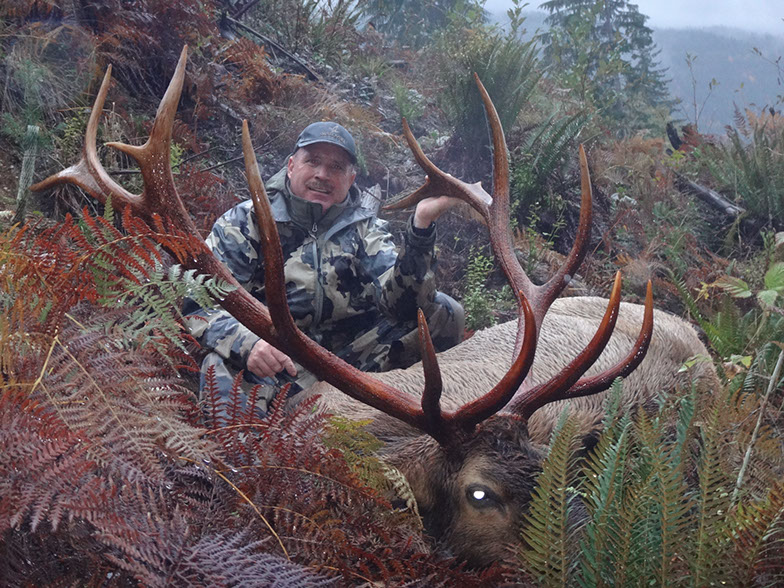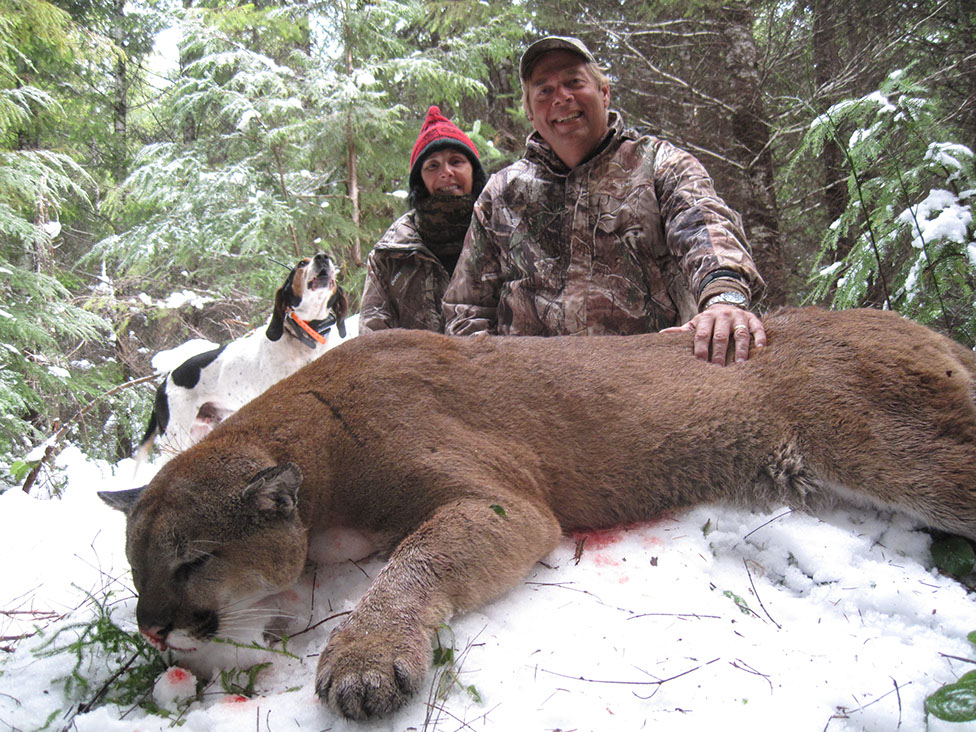Vancouver Island is a wild, mountainous and rough island some 286 miles long and 62 miles wide, being the largest island off the west coast of North America. It has the mildest climate in Canada and averages 70 degrees in summer and 32 degrees in winter. The ocean currents and breezes are responsible for the mild temperature. This warm and relatively moist climate led to huge spruce forests and, for many years, full-scale logging. The result is a ton of logging roads and logged-over/clear-cut areas that attract feeding bears in spring. Add to that excellent habitat the vitamins and nutrition supplied by a huge river-run salmon fishery, plus huge areas of wild berries, and it all translates into great bear habitat. Much of the Island is very wild and remote.
BLACK BEARS
Vancouver Island has probably the densest black bear population anywhere in the world. It is not uncommon to see 10 or more bears in a day. In addition, a few years back, SCI determined that black bears on Vancouver Island (and also those found on Prince of Wales Island in Alaska) were of a slightly different genetic makeup from other blackies. Since they are consistently larger, they created a new classification called “Island Bear”.
This outfitter’s territory is huge – about 1,200 square miles – but what makes it really unique from other operators on the island is that over half of their hunting area is behind locked gates, inaccessible to even local hunters. In addition, the outfitter that had the hunting rights to this territory previously did not take a single bear hunter in over 20 years. Furthermore, while other operators on the island may take 20 bears per year, this outfitter has taken no more than 12 a year in the 5 years they have had this territory. The result is that this outfitter’s area has some GIANT black bears roaming around!
You will typically hunt all day, but the most productive time period is afternoons. Hunts are typically done by ATV and 4WD vehicles, then walking the old roads and glassing clear cuts. You look for fresh droppings, broken trees (a sign of dominance) and bears. The bears often forage on and along the old logging roads, making for interesting walking! Once a big bruin is located, then the stalk is on, and getting close is generally not terribly difficult. You pretty much stick to the old road network, as walking through the timber is a Herculean task.
Hunts are primarily in the spring, but can be in the fall too. He only takes about 4 hunters per week and only 8 per season – a drop in the bucket in such a huge territory! You can use rifle or bow. The accommodations and food are also first-rate, and very appealing for non-hunting observers. These are fantastic hunts for giant bears – many 7-footers, but about 6.5-ft is the average. Many of these are old bruins with big heads, battle scars and bad teeth.
ROOSEVELT ELK HUNTS:
Vancouver Island is believed to have the purest strain of Roosevelt elk in North America. These elk are true giants – the largest bodied elk in North America, and can reach over 1,000 pounds. They can live to 12 or 15 years of age in this rugged and remote country. Although their horns are very massive, they tend to have slightly shorter points than the Rocky Mountain sub-species. But they are a huge animal, and incredibly impressive, and required to complete the North America 29 Slam.
Hunting is normally done much like the bear hunts. You will be hunting using 4WDs and ATVs, and by glassing old and new clear cuts or following up on bugles heard. Because of the heavy cover, this is often best done during the archery season, when vocal bulls can help point you in the right direction, and the thick cover allows you to get close. Of course rifle works quite well too.
This outfitter’s clients take some tremendous bulls, and they have seen or shot at least one Boone & Crockett bull every year. They typically take only 2 archery hunters and 2 rifle hunters each year (light hunting pressure means old bulls!), so their bow hunts are usually booked at least 1 year in advance and their rifle hunts at least 2 years in advance (crossbows are legal, so some rifle hunters opt to use a crossbow instead due to the shorter waiting list).
Like the bear hunts, these elk hunts are not terribly physical – the forest is just too dense for good hunting, so driving old logging roads, glassing clear cuts, etc., is the preferred method of hunting. But as always, being in at least reasonable shape to walk is necessary.
The outfitter gets his allotment of tags for a 5 year period, the newest 5 year cycle will starts in 2022.
He hunts in units 1-2, 1-3, 1-4, and 1-5
MOUNTAIN LIONS
Mountain lions are abundant on Vancouver Island, and hunters in-the-know will tell you that some of the largest lions in the world come from here. These hunts are generally conducted in January and February, and this outfitter has been raising and training hounds for over 20 years so they know what it takes to be successful. A second cat can even be harvested.
2024-2025 PRICES (subject to change without notice until deposit received; all prices in USD)
BEAR (May 16-20 or June 6-10)
$8,900 USD per person 1×1, including taxes, license/tag and government fees. 5-day hunt. Most other outfitters on the island are over $10,000!
MOUNTAIN LION (January/February)
$12,000 USD per person 1×1, including taxes, license/tag and government fees. 7-day hunt. 2nd cat $6,500.
ROOSEVELT ELK (September)
Archery – $37,000 USD per person 1×1, including taxes, license/tag and govt fees. 10-day hunt. (1 opening)
Rifle – $49,000 USD per person 1×1, including taxes, license/tag and govt fees. 10 day hunt.
ACCOMMODATIONS
You will stay in a very modern and luxurious lakeside lodge, with a chef to serve you steaks, prime rib, chicken, seafood and more. They make a serious effort to give you top-notch creature comforts, and you likely gain five pounds here!
GETTING THERE
If you want to take home the meat, the most economical way is to drive. You can route yourself through city of Vancouver and take one of the three ferries located at Departure Bay, Duke Point and Downtown. Duke point is often the choice, but check. You will be heading to Nanaimo, a city of 80,000 people on Vancouver Island. There you will be met. If you fly, it is into Vancouver and then a short flight to Nanaimo Airport (YCD). Again you will be met at airport and driven 2 hours (no charge) to the lodge.
WEATHER
Expect temperature in the 40-60 degree range on spring bear hunts, and some rain. For fall bear or elk, expect 40-70 degrees. Mornings are cool, warming during the day. Winter hunts for lions will usually be much colder of course, but you will be moving following the dogs once they have a cat treed, so dress in layers you can shed.
GETTING YOUR WEAPON INTO CANADA
You are allowed to bring your personal firearm with you. This includes your rifles, shotguns or muzzleloaders (NO HANDGUNS!). For your firearms, a simple one-page form is required to be filled out to obtain a temporary Canadian firearms permit. This form can be down-loaded or mailed to you well in advance from The Royal Canadian Mounted Police at www.cfc-cafc.gc.ca. Click on the link on the left hand side for visitors/non-residents, then download the NON-RESIDENT FIREARM DECLARATION (form RCMP 5589/CAFC 909). Completing this in advance should reduce your time clearing customs. DO NOT SIGN IT UNTIL YOU APPEAR IN FRONT OF CUSTOMS, but fill it out. A confirmed declaration costs a flat fee of $25, regardless of the number of firearms listed on it. It is only valid for the person who signs it and for those firearms listed on the declaration. It is a simple form to fill out. IF YOU HAVE A DUI OR A CRIMINAL RECORD, CALL US! YOU MAY BE DENIED ADMITTANCE. NO FORMS ARE REQUIRED TO BRING YOUR HUNTING BOW INTO CANADA!
TO PREVENT PROBLEMS WHEN RETURNING TO THE UNITED STATES, YOU MUST REGISTER YOUR FIREARMS AND RELATED EQUIPMENT BY TAKING THEM TO ANY CUSTOMS AND BORDER PATROL (“CBP”) OFFICE BEFORE YOU LEAVE THE UNITED STATES. THE CBP OFFICE WILL REGISTER THEM ON THE SAME CBP FORM 4457 USED TO REGISTER CAMERAS AND COMPUTERS. PLEASE NOTE THAT YOU OFTEN CANNOT SIMPLY DO THIS AT THE AIRPORT WHEN LEAVING THE U.S., SO YOU SHOULD DO THIS IN ADVANCE OF YOUR TRIP.




